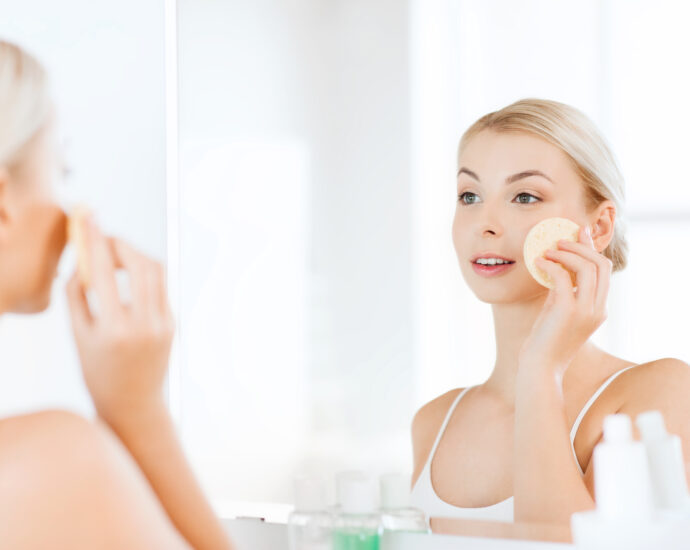Exfoliation refers to the process of removing dead skin cells from the surface of the skin. This can be done through mechanical means, such as using a scrub or a brush, or through chemical means, such as using products containing acids (like alpha hydroxy acids or beta hydroxy acids) that dissolve the bonds between dead skin cells.
Exfoliation helps to reveal fresher, smoother skin underneath and can improve the appearance of the skin by reducing dullness, clearing pores, and enhancing the effectiveness of other skincare products. However, it’s important to exfoliate correctly, as over-exfoliation can lead to skin irritation, dryness, and sensitivity.
Exfoliation offers several health and skincare benefits when done properly.
Here are some key benefits:
- Removes Dead Skin Cells: Exfoliation helps remove the layer of dead skin cells that can accumulate on the skin’s surface, leading to a smoother and more radiant complexion.
- Unclogs Pores: By removing dead skin cells and other debris, exfoliation can prevent clogged pores, reducing the likelihood of acne, blackheads, and whiteheads.
- Improves Skin Texture: Regular exfoliation can make the skin feel softer and smoother by promoting the removal of rough, dry patches and revealing fresh, healthy skin underneath.
- Enhances Absorption of Skincare Products: By removing the barrier of dead skin cells, exfoliation allows serums, moisturizers, and other skincare products to penetrate deeper into the skin, making them more effective.
- Promotes Even Skin Tone: Exfoliation can help to fade dark spots, hyperpigmentation, and acne scars over time, leading to a more even skin tone.
- Stimulates Circulation: Mechanical exfoliation (like scrubs or brushes) can increase blood circulation in the skin, leading to a healthy glow and improved skin vitality.
- Reduces the Appearance of Fine Lines and Wrinkles: Regular exfoliation can help to smooth out fine lines and wrinkles by promoting cell turnover and collagen production.
- Prevents Ingrown Hairs: Exfoliating areas prone to hair removal (like legs or underarms) can help to prevent ingrown hairs by removing dead skin cells that might trap hair follicles.
- Improves Lymphatic Drainage: Gentle exfoliation can stimulate the lymphatic system, helping to remove toxins from the skin and reduce puffiness.
While exfoliation has many benefits, it’s important to use the right products for your skin type and avoid over-exfoliating, as this can lead to irritation and damage to the skin barrier.
Exfoliation is beneficial when done correctly and safely.
Here are some safe ways to exfoliate:
-
Mechanical (Physical) Exfoliation:
- Gentle Scrubs: Use scrubs with small, smooth particles to avoid micro-tears in the skin. Choose products labeled as “gentle” or “for sensitive skin.”
- Exfoliating Brushes or Cloths: Soft-bristled brushes or exfoliating cloths can be used to gently buff away dead skin cells. Avoid harsh scrubbing, especially on sensitive skin.
- Exfoliating Gloves: These can be used in the shower to gently exfoliate the body. Make sure to use gentle pressure.
-
Chemical Exfoliation:
- Alpha Hydroxy Acids (AHAs): These are water-soluble acids, like glycolic or lactic acid, that help dissolve the bonds between dead skin cells. They’re generally safe for dry to normal skin types.
- Beta Hydroxy Acids (BHAs): Salicylic acid is a common BHA that is oil-soluble, making it effective for oily and acne-prone skin. It penetrates pores to clear out sebum and dead skin cells.
- Enzyme Exfoliants: Derived from fruits like papaya or pineapple, enzyme exfoliants are a gentle option for sensitive skin. They break down the keratin in dead skin cells without being too harsh.
- Face: For most skin types, exfoliating 1-3 times per week is sufficient. Sensitive skin types might prefer once a week, while oilier skin types can handle more frequent exfoliation.
- Body: The body can usually handle more frequent exfoliation, but 2-3 times per week is generally safe.
-
Moisturizing After Exfoliation:
- Always follow up exfoliation with a good moisturizer to restore hydration and protect the skin barrier. Look for products with ingredients like hyaluronic acid, glycerin, or ceramides.
- Exfoliation can make the skin more sensitive to the sun. Always apply sunscreen with at least SPF 30 during the day, especially after exfoliating, to protect against UV damage.
-
Patch Testing:
- If you’re trying a new exfoliant, especially chemical ones, do a patch test on a small area of skin first to ensure you don’t have an adverse reaction.
-
Avoiding Over-Exfoliation:
- Over-exfoliation can lead to irritation, redness, and a compromised skin barrier. Signs of over-exfoliation include excessive dryness, peeling, and sensitivity. If you notice these signs, reduce the frequency or switch to a milder exfoliant.
-
Personalized Exfoliation:
- Choose exfoliants based on your skin type. For example, sensitive skin might do better with enzyme exfoliants or mild chemical exfoliants, while oily skin might benefit more from a BHA like salicylic acid.
By following these guidelines, you can safely incorporate exfoliation into your skincare routine and enjoy its benefits without harming your skin.
Exfoliation is a valuable addition to any skincare routine when done correctly, offering a range of benefits from smoother skin texture to improved product absorption and a more even complexion. By choosing the right exfoliation method for your skin type and following safe practices, such as moderating frequency and moisturizing afterward, you can enhance your skin’s health and appearance without the risk of irritation. Remember, the key to effective exfoliation is balance—gentle yet consistent care will leave your skin looking revitalized and radiant.
READ MORE: Nail Care 101: How to Keep Your Nails Strong and Beautiful Naturally
Sources:
https://www.nivea.co.uk/advice/skin/how-to-exfoliate
https://www.goodhousekeeping.com/beauty/anti-aging/a38037984/how-to-exfoliate-face/?utm_source=google&utm_medium=cpc&utm_campaign=mgu_ga_ghk_md_pmx_hybd_mix_us_19597983321&gad_source=1&gclid=CjwKCAjw59q2BhBOEiwAKc0ijZRapABNI07UvOXvy91a_AXBduiNcw8XU-RBPyWvHtrvFYSjFkkLOBoCuQgQAvD_BwE
https://www.byrdie.com/how-to-exfoliate-best-exfoliating-tips-for-the-face-and-body-345926
